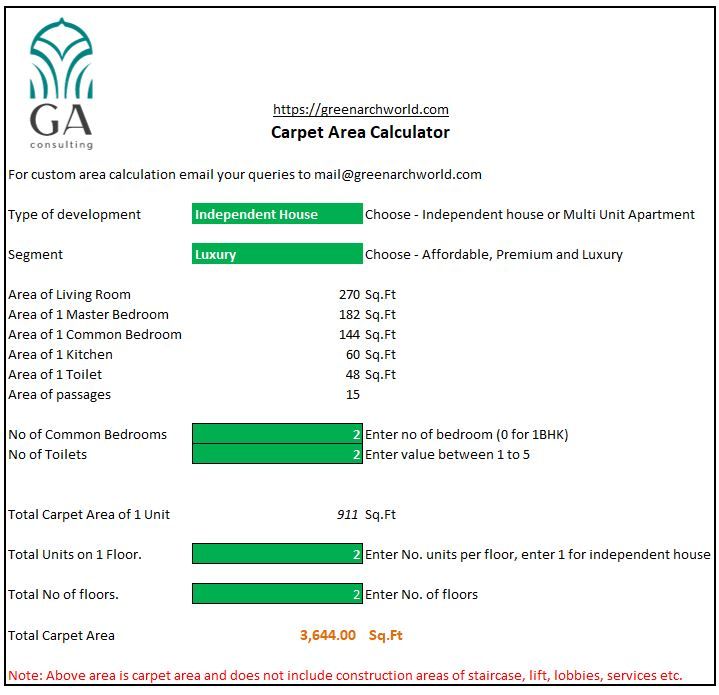
When considering buying or renting a property, understanding terms like carpet area and built-up area is essential. Let’s break down these concepts and delve into carpet area calculation to help you make informed decisions about your residential space.
What is Carpet Area?
Carpet area refers to the total usable floor space within the walls of a property, excluding the thickness of the inner walls. It encompasses areas such as bedrooms, living rooms, kitchens, and bathrooms, providing an accurate representation of the livable space available to occupants.
Importance of Calculating Carpet Area
Calculating the carpet area is vital for homeowners and buyers to understand the true extent of the living space available. This understanding enables informed decisions regarding property value, suitability, and interior design planning. Accurate carpet area measurements are crucial for ensuring that the layout and furnishings complement the available space effectively, thus optimizing living conditions.
How to calculate
Measuring the carpet area involves determining the length and width of each room within the property while excluding the thickness of walls. Precise calculations are necessary for irregularly shaped rooms, where geometric formulas or software tools can ensure accuracy. By breaking down the space into manageable components, stakeholders can obtain reliable estimates of the usable floor area, facilitating efficient planning and utilization of space.
Simple and easy-to-use carpet area calculator excel file for free download. This calculator will allow you to plan for your residential space requirements. You can choose between independent houses or multi-dwelling units also there is a choice for the type of residential segment one is planning, affordable, premium and luxurious. Each of these segments will have different requirements of room sizes and planning requirements. For a custom carpet area calculation excel file contact us with your details at mail@greenarchworld.com.

Please note the excel sheet will work only with excel 2016 and onwards due to the excel operators used in the sheet.
See also: House construction cost calculator
Carpet Area Calculator
The steps to use the carpet area calculator are as follows:
- Download the carpet area calculator excel file.
- Select if you wish to check the carpet area for an independent house or multi-dwelling apartment house.
- Select the type of segment of residential development you are interested in i.e Affordable, Premium & Luxury.
- Check the room sizes for the 3 segments based on your city or location. Modify it as per requirement.
- The carpet area is displayed in square feet.
Benefits of Carpet Area Calculator
Carpet area calculators offer several benefits to stakeholders involved in residential property transactions. These tools simplify the process of estimating floor space, allowing developers, architects, and buyers to quickly assess spatial requirements, plan layouts, and make informed decisions regarding property investments. By providing accurate and reliable measurements, carpet area calculators facilitate efficient communication and negotiation among parties involved in the real estate transaction.
Understanding Built-up Area
Built-up area includes the carpet area along with additional areas such as walls, balconies, and common spaces like corridors and staircases. It represents the total area covered by the property, encompassing both usable and non-usable spaces. This broader measurement offers a comprehensive view of the property’s total area, providing insights into its overall size and structure.
What is the difference between Carpet Area and Built-up Area
- Carpet Area:
- Carpet area refers to the total usable floor space within the walls of a property.
- It includes areas such as bedrooms, living rooms, kitchens, and bathrooms.
- Carpet area excludes the thickness of inner walls, providing an accurate representation of the livable space available to occupants.
- Essentially, it is the area where one can lay a carpet, hence the name.
- Built-Up Area:
- Built-up area includes the carpet area along with additional spaces such as walls, balconies, and common areas like corridors and staircases.
- It represents the total area covered by the property, encompassing both usable and non-usable spaces.
- Built-up area offers a broader measurement of the property’s total area, providing insights into its overall size and structure.
- This measurement accounts for all areas covered by the building structure, including walls and other architectural elements, regardless of their utility to the occupants.
Factors affecting Carpet Area and Built-up Area
Several factors influence both carpet area and built-up area:
- Architectural Design: The layout and design of the property, including the arrangement of rooms and structural elements, can affect both carpet area and built-up area. Efficient design practices can optimize space utilization while maintaining structural integrity.
- Layout Configuration: The configuration of rooms, corridors, and common areas impacts both carpet area and built-up area. Well-planned layouts maximize usable space while ensuring comfort and functionality for occupants.
- Floor-to-Ceiling Heights: The height of ceilings can affect the perceived spaciousness of rooms and impact both carpet area and built-up area calculations. Higher ceilings may contribute to a sense of openness but can also increase construction costs.
- Compliance with Building Regulations: Adherence to building codes and regulations influences both carpet area and built-up area calculations. Compliance ensures structural safety and legal compliance, affecting the overall size and layout of the property.
Compliance with RERA
In many jurisdictions, including India, the Real Estate (Regulation and Development) Act, commonly known as RERA, mandates developers to disclose accurate carpet area measurements in residential projects. This regulation aims to protect the interests of homebuyers by ensuring transparency and consistency in property transactions.
Also see our article on What is RERA carpet area?
Should you pay for Carpet Area or Built-up Area?
Under the RERA (Real Estate Regulation and Development) Act, homebuyers should ideally pay for the carpet area, which specifically refers to the usable floor space within the walls of a property. The RERA act mandates that developers cannot charge for the super built-up area, which includes additional spaces beyond the usable floor space, such as walls, balconies, and common areas like corridors and staircases.
Paying for the carpet area ensures that homebuyers are only charged for the actual livable space available to them, rather than including non-usable spaces in the calculation. This provision aims to protect the interests of homebuyers by promoting transparency and fairness in real estate transactions.
Therefore, when purchasing a property, it’s essential to ensure that you are being charged based on the carpet area as defined by the RERA act. This helps you make informed decisions and ensures that you are paying for the space you will effectively utilize within the property.
Explore on Construction Cost: Calculating Per Square Foot in India





